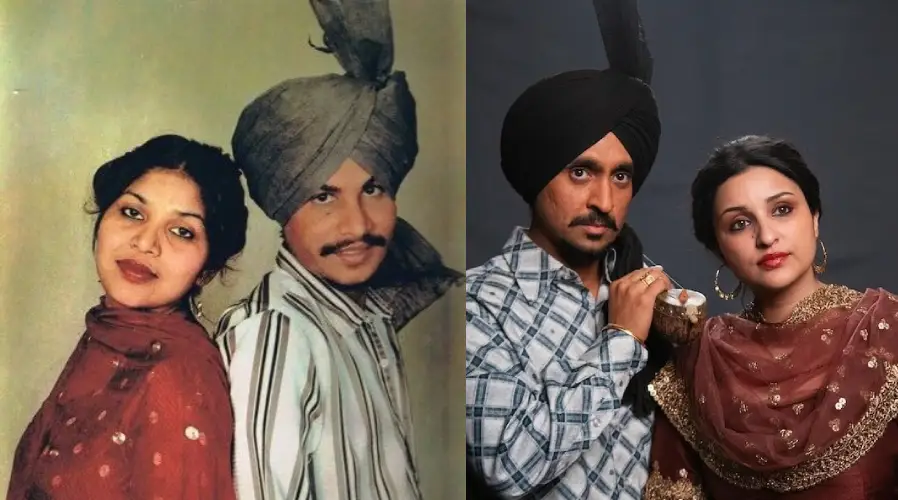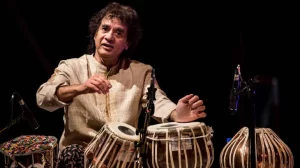“Chamkila,” the biopic of the legendary Punjabi singer Amar Singh Chamkila, made its debut on Netflix on April 12th, directed by the esteemed filmmaker Imtiaz Ali. Starring the popular Punjabi actor Diljit Dosanjh as Amar Singh Chamkila and Parineeti Chopra as Amarjot, the film has stirred up considerable excitement and discussion.
This takes us to the question: Who is Chamkila, and what was his legend?
Often known as the “Elvis of Punjab,” Amar Singh Chamkila was a huge sensation in the music world. He was primarily known for his songs, which, though controversially vulgar, were heavily influenced by the village life he grew up in. For those unfamiliar with his work, one of his most iconic songs, “Pehla Lalkare Naal,” might ring a bell and evoke nostalgia.
Let’s delve into the life of Amar Singh Chamkila: how he met his wife Amarjot and the conspiracy surrounding his death.
CHILDHOOD
Born as Dhanni Ram in 1960 in the small town of Dugri in Ludhiana, Amar Singh Chamkila hailed from an impoverished Dalit family. At the age of six, he developed a fondness for music. However, to support his family, he began working in a cloth mill. It was during this time that his love for music flourished, and he taught himself to play the harmonium, dholak, and his iconic tumbi, a one-string instrument. At the age of 18, he married Gurmail Singh, with whom he had four children. Out of them, two daughters, Amandeep and Kamaldeep, survived.
RISE OF MUSICAL CAREER
In 1979, he caught the attention of Surinder Shinda, marking the beginning of collaborations with renowned Punjabi folk artists like K. Deep and Mohammad Sadiq. Chamkila, adopting the stage name Amar Singh Chamkila that hinted something glittery, teamed up with Surinder Sonia to produce their debut album “Takue Te Takua” in 1980, showcasing his cleverly crafted lyrics. Dissatisfied with his earnings, Chamkila formed his own group, briefly partnering with artists like Usha Kiran and Amar Noorie.
Chamkila rose to fame for his daring and suggestive lyrics, which touched on topics like affairs, drug use, and alcoholism. His songs gained popularity not just in Punjab but also among Punjabi communities around the world. He became so beloved that there were rumors of him performing more shows in a year than there are days, a claim documented in the book “Awaz Mardi Nahin” by Gulzar Singh Shaunki.
Chamkila’s concerts were incredibly popular, with tickets often selling for more than other artists’ shows. He performed not only in India but also in countries like Canada and Dubai. Remarkably, there were occasions when he managed to do two shows in a single day on outdoor stages known as “akhadas.”
WEDDING WITH AMARJOT
Amar Singh encountered Amarjot while searching for a female singer. Although Amarjot lacked formal training at first, they began practicing together, and their partnership soon became renowned for bringing Chamkila’s songs to life with their captivating vocals. Together, they performed at numerous shows, gaining widespread acclaim.
Their relationship took a significant turn when they married, although Amarjot was unaware of Chamkila’s first marriage. This union strengthened their musical bond, and together they had a son named Jaiman. Tragically, Jaiman was barely three years old when the devastating assassination occurred, claiming the lives of his parents.
DEATH AND CONSPIRACY
On May 8, 1988, Chamkila and Amarjot were scheduled to perform an afternoon show in Mehsampur, Punjab’s Jalandhar. As they exited their white ambassador, three masked men on a motorcycle opened fire, killing them both. Chamkila was 27 years old at the time. Two of their accompanying artists also lost their lives. Surprisingly, no FIR was filed, and the killers were never caught.
The incident sparked various conspiracy theories and inspired several films, including “Mehsampur” (2018) by Kabir Chowdhary, “Jodi,” and “Awaaz Nahi Madi.” Some speculate that Chamkila and Amarjot were targeted by local artists threatened by their rising popularity. Others believe it was an honor killing orchestrated by Amarjot’s family due to their caste differences.
While the life of Amar Singh was short-lived, his work has an impacting magnitude that it still continues to be in discussion and enjoyed by many. And hence, this brings us to the answer: This was Amar Singh Chamkila and his sensational legend.







